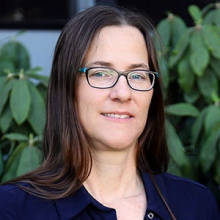-
Title
Staff Scientist -
Email
escher1@llnl.gov -
Phone
(925) 423-2991 -
Organization
Not Available
Research Interests
- Group-theory approaches to nuclear structure and reactions
- Improving nuclear structure inputs for nuclear reactions
- Indirect methods for determining nuclear reaction cross sections for astrophysics and other applications
- Interplay of statistical and direct reactions, formation, and decay of compound nuclei
- Theoretical descriptions of low-energy nuclear reactions
Jutta Escher’s background is in theoretical nuclear physics, and she has worked in low-energy nuclear structure and reaction theory. Her current focus is developing indirect methods for determining cross sections for reactions involving unstable nuclei—such reactions play a crucial role in the quest to understand stellar evolution and the origin of the elements. They are also critical for nuclear-energy applications and for interpreting radiochemical data related to national security applications. Her goal is to achieve microscopic descriptions of the reaction mechanisms involved and to enable indirect measurements at both stable-beam and radioactive beam facilities, such as the Facility for Rare Isotope Beams.
Escher has developed group-theoretical descriptions of nuclear structure and is now investigating avenues for using group-theoretical approaches in nuclear reaction theory. She has (co)organized a number of scientific meetings and is the founding organizer of the international workshop series Compound-Nuclear Reactions and Related Topics.
Ph.D., Physics, Louisiana State University, 1997
M.S., Physics, Louisiana State University, 1993
- J.E. Escher, Emergent phenomena in Atomic Nuclei from Large-scale Modeling: A Symmetry-guided Perspective, “Towards large-scale multi-shell calculations with symmetry-adapted bases: Lessons from the symplectic shell model,” World Scientific, 115–143 (2017).
- Arcones, et al., White paper on nuclear astrophysics and low energy nuclear physics Part 1: Nuclear astrophysics, Progress of Particle and Nuclear Physics 84, 1 (2017).
- G. Potel, G. Perdikakis, B.V. Carlson, M.C. Atkinson, P. Capel, W. H. Dickhoff, J.E. Escher, et al., Toward a complete theory for predicting inclusive deuteron breakup away from stability, Europ. Phys. J. A 53, 178 (2017).
- J.E. Escher, A.P. Tonchev, J.T. Burke, P. Bedrossian, et al., Compound-nuclear reactions with unstable nuclei: Constraining theory through innovative experimental approaches, EPJ Web of Conf. 122, 12001 (2016).
- L. Hlophe, V. Eremenko, Ch. Elster, F.M. Nunes, G. Arbanas, J.E. Escher, and I.J. Thompson, Separable Representation of Proton-Nucleus Optical Potentials, Phys. Rev. C 90, 061602(R) (2014).
- B.V. Carlson, J.E. Escher, and M.S. Hussein, Theoretical descriptions of compound-nuclear reactions: open problems & challenges, J. Phys. G 41, 094003 (2014).
- J.E. Escher, I.J. Thompson, G. Arbanas, Ch. Elster, V. Eremenko, L. Hlophe, and F.M. Nunes, Revisiting surface-integral formulations for one-nucleon transfers to bound and resonance states, Phys. Rev. C 89, 054605 (2014).
- L. Hlophe, Ch. Elster, R.C. Johnson, N.J. Upadhyay, F.M. Nunes, G. Arbanas, V. Eremenko, J.E. Escher, and I.J. Thompson, Separable Representation of Phenomenological Optical Potentials of Woods-Saxon Type, Phys. Rev. C 88, 0064608 (2013).
- J.E. Escher, J.T. Burke, F.S. Dietrich, N.D. Scielzo, I.J. Thompson, and W. Younes, Compound-nuclear reaction cross sections from surrogate measurements, Reviews of Modern Physics 84, 353 (2012).
- G.P.A. Nobre, F.S. Dietrich, J.E. Escher, I.J. Thompson, M. Dupuis, J. Terasaki, and J. Engel, Toward a microscopic reaction description based on energy-density-functional structure models, Phys. Rev. C 84, 064609 (2011).
- G.P.A. Nobre, F.S. Dietrich, J.E. Escher, I.J. Thompson, M. Dupuis, J. Terasaki, and J. Engel, Coupled-channels calculations of nonelastic cross sections using a density-functional structure model, Phys. Rev. Lett. 105, 202520 (2010).
- J.E. Escher and F.S. Dietrich, Cross sections for neutron capture from surrogate measurements: An examination of Weisskopf-Ewing and ratio approximations, Phys. Rev. C 81, 024612 (2010).
- C. Forssen, F.S. Dietrich, J. Escher, R. Hoffman, and K. Kelley, Determining neutron-capture cross sections via the surrogate reaction technique, Phys. Rev. C 75, 055807 (2007).
- J. Escher and F. S. Dietrich, Determining (n,f) cross sections for actinide nuclei indirectly: An examination of the Surrogate Ratio Method, Phys. Rev. C 74, 054601 (2006).
- J. Al-Khalili, C. Barbieri, J. Escher, B.K. Jennings, J.-M. Sparenberg, Many-body Approach to Proton Emission and the Role of Spectroscopic Factors, Phys. Rev. C 68, 024314 (2003).
- J. Escher and B. K. Jennings, One-body Overlap Functions, Equations of Motion, and Phenomenological Potentials, Phys. Rev. C 66, 034313 (2002).
- J. Escher and A. Leviatan, Partial Dynamical Symmetry in the Symplectic Shell Model, Phys. Rev. C 65, 054309 (2002).
- J. Escher, B. K. Jennings, and H. S. Sherif, Spectroscopic Amplitudes and Microscopic Substructure Effects in Nucleon Capture Reactions, Phys. Rev. C 64, 065801 (2001).
- J. Escher and A. Leviatan, Partial Dynamical Symmetry in a Fermion System, Phys. Rev. Lett. 84, 1866 (2000).
- J. Escher and J. P. Draayer, Electron Scattering and Multi-hω Correlations, Phys. Rev. Lett. 82, 5221 (1999).
- J. Escher and J. P. Draayer, Fermion Realization of the Nuclear Sp(6,R) Model, J. Math. Phys. 39, 5123 (1998).
- PLS Directorate Award, Developing Nuclear Data Evaluation Capability, LLNL, 2018
- PLS/NACS Spot Award, Theory for Surrogate Nuclear Reactions, LLNL, 2017
- PLS Directorate Award, Excellence in Publishing, LLNL, 2012
- PLS Directorate Award, Conference Organization, LLNL, 2009
- Phi Kappa Phi National Honor Society, 1991
- Fulbright Scholarship, 1989


